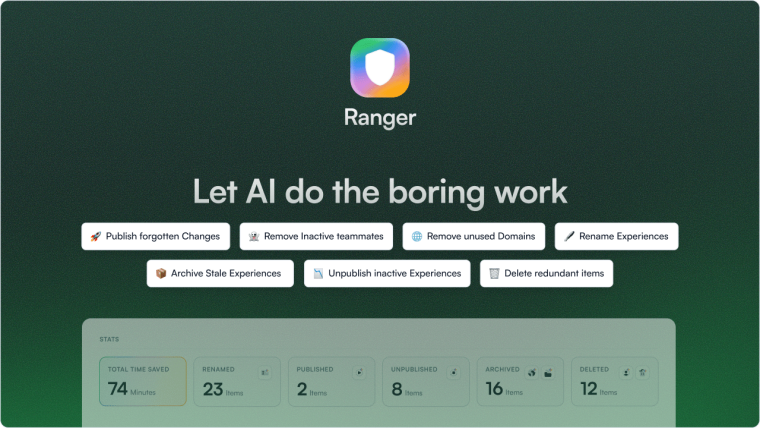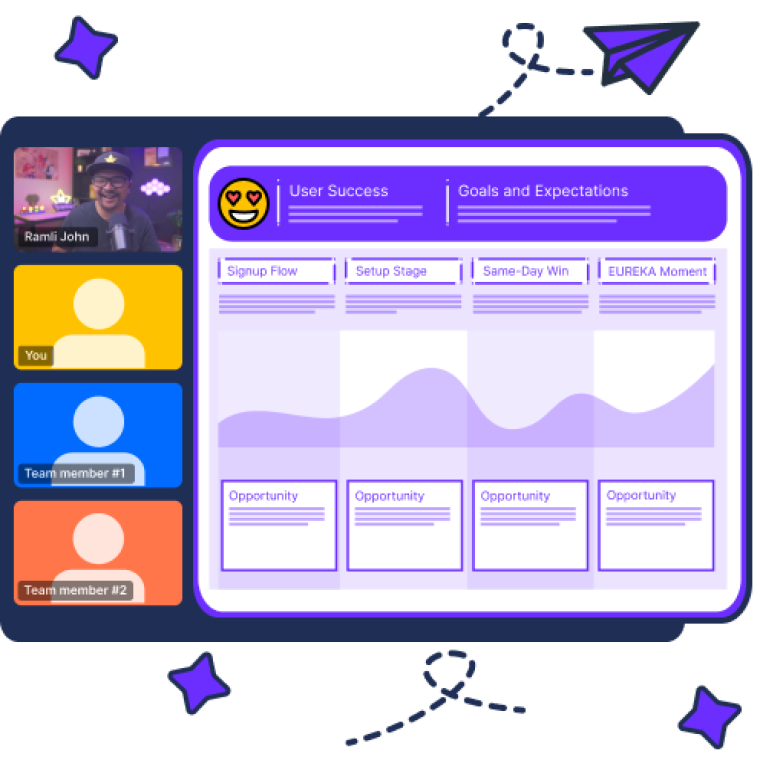You’ve finally bought that product adoption platform. The contract has been signed and you’re ready to dive into its features. Now the question is, how do you make the best out of it? How do you set yourself up for lasting success?
In this article, we’re going to talk about what you can do within the first month of using your product adoption platform in order to have the most constructive first month that will set you up for continuous ROI from using a product adoption tool.
The aftercare of new software like Chameleon is twofold: on one side, it involves how you make the best out of the software itself, and on the other, it includes the level and quality of the support you’re getting.
Keep those two elements in mind. We'll be covering them in detail. Let's get into it.
Making the most out of a product adoption tool involves keeping it organized, knowing what your users need and how the tool can help you provide it. Plus, maintaining it active and using it to experiment and explore with in-product experiences.
Using a new product successfully depends in part on how good customer support is from the other end. What can the product's CS team do to help you see ROI?
It also includes your involvement: what can you do to ensure that you're receiving the type of support and guidance you need?
Educational resources can be your best friends: explore how you can make the best out of support provided beyond interactions with the CS team.
The first month checklist for product adoption platform aftercare
Your success with a product adoption tool like Chameleon depends highly on how well you maintain the software, from keeping your data and experiences in order to make the best use of the features and products available.
We asked our fabulous Customer Success team what will make or break your success with a platform like Chameleon, and here are some of the key points that they advise customers to stay on top of.
Keep it organized
Once you start actively using your product adoption software, it will quickly get packed with built experiences, drafts, templates, and user data. Keeping everything organized will prevent stressful and time-consuming situations where you cannot properly manage or control the monster you've created.
Keep your tool in order by following these 3 organizational tips:
- Create a naming convention: You can create naming groups with relevant information like use case, target audience, and date created to help you quickly identify experiences in your log. For example, Onboarding Tour - New Users 11-2022.
- Use tags to group experiences: If you're using Chameleon, you can add Tags to all experiences to categorize them into groups. This makes it easier to filter and manage the Experiences you build across your product.
- Delete or archive old drafts or inactive experiences: Reduce the volume of static information that can be clouding the visibility of the experiences you should be tracking.
Remember, the earlier you get yourself organized the easier to keep track of everything. Otherwise, you'd be retro-organizing a mess that has been building for months. That's why you have to get a handle of this the first month, if not the first day.
Know your product friction
When you first signed up for a product adoption tool you had a problem to solve: you needed to improve user onboarding to retain more users, engage more users in product surveys, offer more self-serve guidance, or any other of the many use cases a product adoption platform has.
After you solve your initial use case, you will likely see other problem areas the tool could address. The key to identifying more use cases is to figure out where product friction occurs.
For this, the question that should always be burning your mind when working with a product adoption software is: What is preventing users from taking key actions?
There are a few things you can do with the platform to help you start answering that question, like:
- Use in-app surveys to ask users what they're trying to achieve with your product, then cross-reference responses with user behavior data in your analytics tool. For example: What steps did the user take to achieve what they expected from your product? What actions did they perform after finding their "aha!" moment?
- Measure the immediate impact of adding in-product guidance on helping users perform key actions, activate essential features, or complete an onboarding flow. For example: Did they do what you expected them to after completing an onboarding tour?
- Experiment with A/B testing and targeted variations of in-app messages. For example: Measure the impact that adding images or personalizing the copy has on users interacting with in-app messages.
We'll dig deeper into these below.
Need help identifying and targeting friction? We'll give you hand:
🐛 What is the product adoption bug?
Know your goals and keep them in sight
Each experience you create should have a clear single goal and an established metric of success. Losing sight of your product goals can lead users to frustration as they are overwhelmed with irrelevant information that doesn't help them find success with your product.
A goal-oriented experience should be built with clear intent: what exactly do you expect users to accomplish by interacting with this experience inside your product?
The answer to this question should give you the right metrics to look out for when assessing the effectiveness of your in-app experiences.
For example, if after viewing a tooltip about a new feature release you want users to activate the feature, then you know you should be looking for those activation rates.
Know what it means to be user-centric
Creating effective in-product experiences is all about putting your users first. Being user-centric in your approach will ensure that you stay on top of some of the best practices we already covered here, like knowing your product friction and being goal-oriented.
So know exactly what it means to be user-centric in your case under the contexts you will deploy your in-app experiences.
“Being customer-centric is more than just putting customers first—it’s about flipping the company’s culture, goals, and metrics to be focused around solving a set of problems for a set of customers, thus bringing the customers’ happiness to the driving seat.” — Tiago Mota, Head of Customer Success at Chameleon
Perform experiments
Product adoption platforms are engines for growth that needs to be continuously maintained. Setting-and-forgetting in-app experiences means you're not taking advantage of one of the most valuable benefits of using a digital adoption tool: the ability to create, edit, and publish experiences quickly.
The ease of use of the platform and control over the publication of in-app messages allow you to constantly deliver exactly what your users need, in real-time. That facilitates the process of revising strategies, deactivating flows that aren't working, or deploying quick-fixes.
Iteration also works alongside experimentation as one complements the other. Feedback from your testing can properly guide your adjustments to your user experiences, each iteration improving your product adoption.
Testing and experimentation are critical parts of implementing and maintaining a product adoption tool as well as the biggest catalyzers of success.
Product adoption is a trial and error field: there isn't a one-size-fits-all recipe for success, instead, you must find a strategy that is contextual to your product and user base.
With Chameleon, for example, you can use audience segmentation filters and integrations with product analytics tools to A/B test your in-app experiments amongst controlled or specific test groups.
How to have a fantastic first month with customer success teams
Customer Support is a quintessential part of a great product experience. They’re the ones that unblock you whenever you run into a problem or educate you on how you can get more value out of the product.
How good the customer support you receive depends partly on what you do as a customer. Your relationship with another company's Customer Success or Support teams is a partnership, and there are certain things you can do to make the best out of this dynamic.
So here are some tips and tricks to ensure that you get the best help and guidance from your product adoption software’s customer success team starting from your very first month.
Have a metric to measure the product’s success
In order to know if the solution you’ve chosen is actually working to achieve your goal for implementing it, you need to be able to track its success, and you need to have a metric in mind that you can reliably measure and monitor.
For instance: Is there a meaningful number of conversions coming from onboarding experiences built with the product? How does this compare to the baseline figure before the product was implemented? What’s the trendline looking like over a longer period of time?
Having such clear metrics helps the Customer Success team guide you toward meeting your goals.
Build a good relationship with your vendor’s CS team early on
Depending on your preferences, you might reach out for support when you encounter an issue, or you might prefer finding an answer on your own without ever talking to the support team.
If the latter is the case, we encourage you to reach out to CS if you cannot easily self-serve the knowledge that you need as this might help you overcome issues faster.
As our customer Technical Champion, Kevin Brown, puts it, “customers who have better communication with the support team get much more out of the product.”
Why is this? Because they are able to better articulate and express their needs in regard to their specific use cases and objectives.
How do you set up good communication? You need to establish a continuous relationship with the CS team with regular check-ins and reporting. Like any other human interaction, the more familiar and comfortable you are with the other party, the more effectively you’ll be able to say the things you need to say.
Since it’s much harder to establish this kind of relationship than to just maintain it, make sure to set up the conversation early on. Have regular meetings where you bring up all sorts of questions regarding the product to the CS team. They’ll be happy you asked.
Be curious about the product
Even more important than your communication with the Customer Success team is your general attitude toward the product.
If you’re generally apathetic and indifferent about what the product can do, then you won’t have much to ask, and the support managers won’t be able to help you much without some information on what you want to achieve with the product. It’d be like coaching an athlete who doesn’t care much about winning or losing.
This is why it’s important to stay curious about the product. You have to be in the mindset of “what else can I do with this?”
Kevin Brown sums it up best: “You’re already paying for this whole product, so why not expand your use case?”
Once you are more curious about what the product can do, more possibilities with the product will open up, and the Customer Success team will be happy to guide you on your way.
Find synergies between different parts of the product
A product usually comprises different features. You may buy a product adoption platform for singular use cases such as creating better user onboarding or driving more upsells and cross-sells from within your product.
But user experience is a system, not just a single experience. Driving adoption is not just about how you educate users through Tours, or give nudges with Tooltips. It’s about how they all work in concert with each other.
This is why you have to look at finding synergies between different parts of the product adoption platform and tying it all together to achieve your goals and see the ROI more quickly.
Are there unique ways you can combine different features to create more enriching onboarding experiences? Could there be a way to achieve a use case that is not possible with just one feature, but can be done when multiple features are working together? Constantly ask more from the software, and push it to its limits. This is the kind of stuff that success teams love to hear from their customers.
Beyond the first month: how to have a great long-term relationship with the vendor
A great product experience goes beyond positive product performance and robust CS support at first. Far too many times, you can find yourself in a honeymoon phase with a product, after which you might notice that the quality of support decreases.
This is why the best long-term B2B SaaS relationships act as genuine partnerships. These are some of the extra qualities you should look out for when assessing how far this product relationship can take you beyond the first month.
How thorough the customer education is
Your short- and long-term success with the product depends on how well you get to know the product from the get-go, and how much value you can get out of it.
For instance, a great product partnership should include a thorough go-live plan that coaches your team through implementation so that you can quickly start using the product for your first use cases.
Additional training should also follow in order to make sure you’re getting the most value out of the product. This can happen in 1-on-1 calls or through active support in product-related live events you attend.
Furthermore, get familiar with available self-serve resources. A lot of your day-to-day issues with the product are likely to be simple concerns that could be addressed by a brief help article. You don’t want to have to go to customer support for even the smallest problems.
The help docs, videos, courses, and other relevant educational resources are typically going to be within a knowledge base. Additionally, you might find them within in-product help menus, onboarding checklists, or linked to product tours and feature walkthroughs. The more searchable the knowledge base is, the better.
Contacting the customer success team can result in a fair amount of back and forth until you get to a solution, or even scheduling conflicts that make the interaction more difficult. . Instead, it would be much more efficient if you could just read an article and find the answer yourself.
💡Chameleon tip: If you’d like to make your own knowledge base searchable, you can do that with Chameleon’s HelpBar. It’s currently in Beta, and you can try it out to enable your users to quickly find the answers they need exactly when they need them. This might be the added value of a product adoption software you were looking for 😇
The quality of customer support
No matter how thorough the customer education is, you’re going to run into issues. This is where great customer support comes in.
There are two core aspects to this: speed and quality. An issue should be resolved as quickly as possible so that you can continue using the product. It should also be resolved in a thorough manner so that there is no further back and forth regarding it.
A big part of this is the quality of support the Customer Success team is providing. An excellent CSM who can bring clarity fast to an issue makes all the difference.
Here are some characteristics that make a great Customer Success Manager:
- Empathy: a good CSM should be able to understand your point of view and take interest in your company and its mission.
- Patience: a CSM should be patient enough to guide you through all the difficulties, no matter the obstacles, and eventually arrive at a satisfying solution.
- Preparedness: every interaction with a CSM should be as efficient and effective as possible. For this, a CSM should be well prepared by researching ahead of time in regard to your context.
- Reliability: a good CSM should be someone that you could lean on. This means that they not only never let the customer hang out to dry, but do everything they can to resolve the issue, even if it’s something beyond their capacity.
Ask yourself if the CSM you’re dealing with has these above qualities. Do you feel that they know what your company is trying to do, and align the solution with the context? Do you feel that all of your concerns are met with sincerity and poise? Do you feel that in every meeting you can count on them to bring excellent insights based on prior research? Do you get prompt and clear responses, and feel that you can trust the CSM to resolve your issues? The answer should be yes to all of them.
How above and beyond the customer support goes
Generally, customer success is understood as a reactive process. Whenever there is a problem, a customer support team member steps up to find a resolution. This is widely regarded as the standard vendor-customer dynamic.
However, true customer success comes not from reactive, but proactive customer support. It is when your vendor’s team reaches out to you on their own, without any prompting on your part, purely for the sake of making your experience better.
Examples of proactive customer support include:
- Regular check-ins: these are meetings that are established ahead of time at designated intervals, whether once every quarter or once every two months. They generally look at how satisfied you are with your experience with the product, and whether there can be any improvements made.
- Expert sessions: these can come in the form of calls during which customer success managers show you deeper use cases that you might be missing out on, or showing you a better way of using the solution.
It also includes how much value customer support gives outside of simply giving you a good experience with the product. For instance, Chameleon provides asynchronous design feedback for any Experience created with its builder, so that users can make improvements that will boost their product adoption. This level of support pushes customer success even further.
How the product is managed
Lastly, take a close look at how the product is managed by the company. How much energy do they spend to constantly improve the product? Is the product progressively evolving to broaden and deepen customer use cases, or is it more or less stagnant for long periods of time?
For instance, are there frequent updates that resolve known issues? Is the company constantly developing new features and add-ons that meaningfully enrich your experience?
You want a product that grows constantly and doesn’t take anything for granted. That way, you’ll be getting increasing value out of the tool into the future, whether in the form of a better experience for you and your customers, or potential use cases that will arise when new features are introduced into the product.
Also, see if your feedback is incorporated into the product. Whenever you tell the team that certain things are lacking or are in need of improvement, are those things actually addressed through updates? When you say you would like to see certain other features, do those features actually get made down the line?
As we all know, product management is a conversation between the vendor and the customer, and for that, feedback should always be seriously considered.
Bringing it all together
So that about sums it up for what you should do and look out for in the first month.
Like every highly sophisticated and capable tool, a product adoption platform is just as good as how you use it. It could be the driver of conversion and retention that you’ve been dreaming about. Or it can end up as another line in your list of expenses.
Use your tool with purpose in every instance. Stay organized and align your objectives across the organization so that experiences aren’t being created willy-nilly. You want every single in-product experience to be part of a bigger picture.
And most of all, keep your eye on the prize. Recall why you wanted to get a product adoption platform in the first place. You likely got it because you wanted to solve a problem. So do that. If low conversion rates were your issue, then leverage the solution to figure out how to activate more users and convert them better. Remember your goals and apply the tool to reach them. That is probably the single most important thing to take away from all of this.
Now go out there and become product adoption masters!
Want to try out Chameleon to see if it’s the right fit for you? Sign up for free or hop on a 1-on-1 expert call. 👇
.gif)
Choose the best product adoption platform
Building a successful product is hard; make it easier by using the deepest solution to drive feature usage







